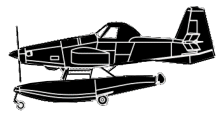
ASN Wikibase Occurrence # 168820
This information is added by users of ASN. Neither ASN nor the Flight Safety Foundation are responsible for the completeness or correctness of this information.
If you feel this information is incomplete or incorrect, you can submit corrected information.
| Date: | Thursday 14 August 2014 |
| Time: | 00:40 UTC |
| Type: |  Air Tractor AT-802A Fire Boss |
| Owner/operator: | Conair Group |
| Registration: | C-GXNX |
| MSN: | 802A-0530 |
| Year of manufacture: | 2013 |
| Fatalities: | Fatalities: 0 / Occupants: 1 |
| Aircraft damage: | Destroyed |
| Category: | Accident |
| Location: | Chantslar Lake, 16nm E of Puntzi Mountain, BC -
 Canada Canada
|
| Phase: | Manoeuvring (airshow, firefighting, ag.ops.) |
| Nature: | Fire fighting |
| Departure airport: | Puntzi Mountain Aerodrome (CYPU) |
| Puntzi Mountain Aerodrome (CYPU) | |
| Investigating agency: | TSB |
| Confidence Rating: |
A float-equipped Air Tractor AT-802A (registration C-GXNX, operating as Tanker 685, was carrying out wildfire management operations near Chantslar Lake, British Columbia with 3 other aircraft of the same model. C-GXNX was second in the formation on a touch-and-go to pick up water. Upon lift-off, a control issue occurred and the aircraft struck the water, crashed and subsequently sank. The third aircraft in the formation exercised the precaution of dumping its water load and manoeuvring to stay clear of any contact with the accident aircraft as it continued its take-off. The fourth aircraft also dumped its water load but rejected the take-off and taxied to pick up the pilot in the water.
The pilot was wearing a helmet, a personal floatation device (PFD) and a 4-point safety harness. Pilot was able to egress, inflate his PFD and was held overnight in a hospital and released next morning (Friday 15th).
Findings as to causes and contributing factors
A wing stalled either independently or in combination with an encounter with a wing-tip vortex generated by the lead aircraft. This caused a loss of control moments after liftoff, and resulted in the right-hand wing tip contacting the water and in a subsequent water-loop.
The operator's standard takeoff procedures did not specify a liftoff speed for scooping operations. Lifting off below the published power-off stall speed contributed to a loss of control at an altitude insufficient to permit a recovery.
The takeoff condition, with the aircraft heavy, its speed below the published power-off stall speed, and a high angle-of-attack contributed to the loss of control.
An understaffed management structure during organizational changes likely led to excessive workload for existing managers. This contributed to risks, contained within the standard operating procedures, not being addressed through the operator's safety management system, resulting in continued aircraft operations below published minimum airspeed limitations.
Findings as to risk
If takeoff procedures do not specify a liftoff speed, pilots may take advantage of engine power and pitch control capability to get airborne below the published stall speed, risking loss of control at an altitude insufficient to permit a recovery.
If the aircraft is operated outside of the demonstrated flight envelope, there is a risk that pilots will be exposed to aircraft performance for which they are not prepared.
If organizations do not maintain the necessary management resources to oversee effective safety management practices, long-term efforts may dissipate, resulting in the risk of unsafe practices persisting in flight operations.
Other findings
The exposed rudder control cables on the floor, which run along both sides of the pilot's seat, may be subject to interference by items placed on top of them.
The exposed elevator control push-pull tube, under the pilot's seat, may be subject to interference by loose objects on the floor
Accident investigation:
 |
|
Sources:
Cadors Number: 2014P1342
http://fireaviation.com/2014/08/15/seat-sinks-in-british-columbia-lake/
http://www.regosearch.com/aircraft/ca/GXNX
https://globalnews.ca/news/1511422/pilot-uninjured-after-water-bomber-crash-in-the-cariboo/
http://www.bst-tsb.gc.ca/eng/rapports-reports/aviation/2014/a14p0132/a14p0132.asp
Images:

Photo: TSB
Revision history:
| Date/time | Contributor | Updates |
|---|---|---|
| 17-Aug-2014 09:24 | Aerossurance | Added |
| 26-Aug-2014 05:30 | Aerossurance | Updated [Narrative] |
| 20-Nov-2016 16:47 | Aerossurance | Updated [Location, Departure airport, Destination airport, Source, Narrative] |
| 14-Aug-2021 09:21 | Aerossurance | Updated [Embed code] |
| 14-Dec-2021 20:59 | Anon. | Updated [Aircraft type, Embed code] |
| 14-Dec-2021 21:04 | harro | Updated [Operator, Narrative] |
Corrections or additions? ... Edit this accident description
The Aviation Safety Network is an exclusive service provided by:


 ©2024 Flight Safety Foundation
©2024 Flight Safety Foundation